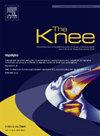后足内翻畸形患者全膝关节置换术后膝关节和足部临床评分下降
IF 2
4区 医学
Q3 ORTHOPEDICS
引用次数: 0
摘要
目的利用胫跟角(TCA)评价后足对中值,对了解全膝关节置换术(TKA)前后下肢负荷轴有重要意义。然而,之前没有研究调查日本患者TCA分类与TKA后临床结果的关系,包括TCA内翻和外翻畸形的患者。本研究旨在探讨TCA与TKA后膝关节和足部预后之间的关系。方法前瞻性评估2020年10月至2021年10月在我校及其附属医院接受原发性骨关节炎TKA的患者。根据术前TCA将患者分为内翻(<0°)、中翻(0 - 8°)和外翻(>8°)组。术前、术后6个月和1年的临床结果采用新的膝关节学会评分系统(KSS, 2011)、牛津膝关节评分(OKS)和5项SAFE-Q (SQ)进行评估。统计学分析采用Kruskal-Wallis检验、Dunn’s多重比较检验和logistic回归分析。结果内翻组患者6个月、12个月KSS、OKS均显著低于对照组(p < 0.05)。6个月时,内翻组在社交生活功能、鞋子相关问题和整体健康方面得分明显较低(p < 0.05)。Logistic回归分析显示,TCA内翻是术后1年KSS、OKS、SQ、社会生活功能和整体健康降低的独立因素(优势比:2.73、2.95、1.90、2.23;p < 0.05)。结论:总的来说,我们的研究结果表明,后足内翻畸形患者在全膝关节置换术后膝关节和足部临床评分下降。本文章由计算机程序翻译,如有差异,请以英文原文为准。
Patients with varus hindfoot deformity show decreased knee and foot clinical scores after total knee arthroplasty
Objective
Evaluating hindfoot alignment using the tibiocalcaneal angle (TCA) is important for understanding the lower limb load axis before and after total knee arthroplasty (TKA). However, no previous studies have investigated the relationship between TCA classification and clinical outcomes after TKA in Japanese patients, including those with TCA varus and valgus deformities. This study aimed to examine the relationship between TCA and knee and foot outcomes following TKA.
Methods
Patients who underwent primary TKA for osteoarthritis at our university and affiliated hospitals between October 2020 and October 2021 were prospectively evaluated. Based on preoperative TCA, patients were categorized into varus (<0°), intermediate (0–8°), and valgus (>8°) groups. Preoperative, 6-month, and 1-year postoperative clinical outcomes were assessed using the new Knee Society Scoring System (KSS, 2011), Oxford Knee Score (OKS), and the 5-item SAFE-Q (SQ). Statistical analysis was performed using the Kruskal-Wallis test, Dunn’s multiple comparison test, and logistic regression analysis.
Results
Both the KSS and OKS were significantly lower in the varus group at 6 and 12 months (p < 0.05). At 6 months, the varus group had significantly lower scores on social life functions, shoe-related issues, and overall health (p < 0.05). Logistic regression analysis showed that TCA varus was an independent factor that reduced KSS, OKS, SQ, social life function, and overall health 1-year postoperatively (odds ratios: 2.73, 2.95, 1.90, 2.23; p < 0.05).
Conclusion
Overall, our findings suggest that the patients with varus hindfoot deformity show decreases in knee and foot clinical scores following total knee arthroplasty.
求助全文
通过发布文献求助,成功后即可免费获取论文全文。
去求助
来源期刊

Knee
医学-外科
CiteScore
3.80
自引率
5.30%
发文量
171
审稿时长
6 months
期刊介绍:
The Knee is an international journal publishing studies on the clinical treatment and fundamental biomechanical characteristics of this joint. The aim of the journal is to provide a vehicle relevant to surgeons, biomedical engineers, imaging specialists, materials scientists, rehabilitation personnel and all those with an interest in the knee.
The topics covered include, but are not limited to:
• Anatomy, physiology, morphology and biochemistry;
• Biomechanical studies;
• Advances in the development of prosthetic, orthotic and augmentation devices;
• Imaging and diagnostic techniques;
• Pathology;
• Trauma;
• Surgery;
• Rehabilitation.
 求助内容:
求助内容: 应助结果提醒方式:
应助结果提醒方式:


